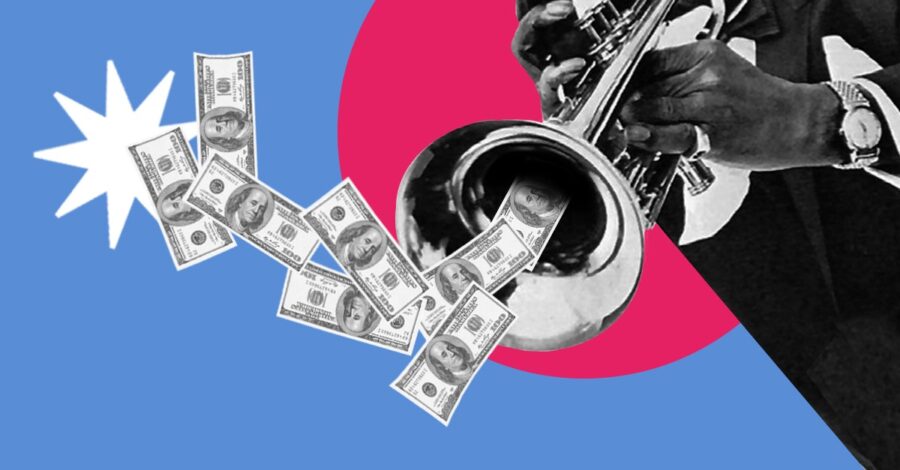Streaming: High Volume, Low Pay
Music streaming now dominates the global music market, generating over $20 billion in 2024 and accounting for nearly 70% of worldwide industry revenues. In North America and Europe, platforms like Spotify and Apple Music are near-monopolistic in their market share. In the U.S., streaming makes up around 84% of the music industry’s income; in the UK, it’s approximately 68%. Despite these impressive figures, the artist’s share remains minimal.
Streaming services typically keep about 30% of subscription revenue, while the remaining 70% is distributed to rights holders – usually record labels, not artists directly. Most artists receive only fractions of a cent per stream. For example, Spotify pays around $0.004 per stream; Apple Music or Tidal pays slightly more. To match the profit of selling a single band T-shirt (approx. $38), an artist needs almost 12,000 streams. The reality is stark: millions of tracks receive zero plays, while a handful of top songs rake in over a billion. For the majority, streaming is a promotional tool rather than a reliable income source.
Spotify recently introduced a controversial threshold: as of 2024, songs must garner at least 1,000 annual streams to earn any royalties. While intended to reduce fraud and redistribute funds to more popular artists, critics argue this policy further marginalizes newcomers. Independent artists who distribute directly can keep 80–100% of their income, yet even then, total earnings are usually modest. In the end, streaming remains profitable only for a small elite of global hitmakers.
Live Performances: Post-Pandemic Boom Meets Rising Costs
Following pandemic-era shutdowns, live performances rebounded dramatically. Global concert revenues surged, with major tours generating billions. Taylor Swift’s 2023 tour alone grossed over $1 billion. Large-scale festivals and arena tours in Europe and North America have also reached historic highs. Projections show that the live music sector may grow to nearly $80 billion globally by 2030.
However, this growth does not benefit everyone equally. While mega-stars enjoy VIP ticket packages and corporate sponsorships, mid-level and emerging artists often struggle. Rising costs for crews, transport, and logistics cut deeply into potential profits. In Canada, data show that artists receive only a small fraction of total live sector revenues, with venues and promoters capturing the lion’s share. In the UK, artists describe a “cost-of-touring crisis,” where even successful tours may run at a loss.
Some musicians are responding creatively. Hybrid events, smaller club tours, and livestreams via platforms like Twitch or YouTube offer new ways to perform. Others are lobbying for tax incentives and government support for grassroots venues. Nevertheless, even for well-known acts, touring can be a financial gamble. Many invest years in equipment and travel before seeing real returns.
Licensing: The Sync Goldmine
Licensing songs for film, television, advertising, and video games known as “sync” deals can be a lucrative avenue for musicians. While synchronization revenue accounts for a relatively small portion of the global market, individual deals can yield substantial payouts, especially for major productions. Licensing typically involves two payments: one for the recording and one for the composition. Additional royalties may follow from ongoing usage.
Placement in a high-profile show or video game can lead to a resurgence in popularity, dramatically boosting streaming and sales. Sync licensing also allows older or niche tracks to find new audiences. However, access to this market is highly competitive and often gatekept by labels or specialized agencies.
The COVID pandemic and recent Hollywood strikes disrupted sync licensing workflows, slowing production pipelines. While the commercial sector remained relatively stable, film and television slowed down. As the industry recovers, musicians and rights holders are reengaging with this revenue stream, though opportunities remain limited for independent artists without representation.
Merchandising, High Margins and Fan Connection
Merchandise is a cornerstone of many musicians’ income strategies. T-shirts, posters, vinyl, and limited-edition goods offer far higher margins than streaming and create lasting fan engagement. Studies show that about 20% of concertgoers buy merchandise, a number that has nearly doubled since 2019.
Even small shows can generate thousands of dollars in merchandise sales. For example, a single club show with under 1,500 attendees may yield over $5,000 in merch revenue, often nine times what the same artist would earn from streaming in a year.
Platforms like Bandcamp enable direct-to-fan sales with minimal overhead. Artists typically retain 85–90% of revenue, and special promotional days increase income further. Independent webshops and limited drops of vinyl or signed items also boost engagement and revenue. Compared to the razor-thin margins of streaming, merchandising remains one of the most profitable and personal revenue channels for working musicians.
Social Media and the Creator Economy
Social media is no longer just a marketing tool it’s a monetization engine. YouTube enables direct ad revenue for music content. TikTok, though less predictable in its payouts, can catapult songs into virality. Artists earn a small amount per user video that uses their sound, but the real value lies in the exposure and subsequent streaming or merch sales.
Platforms like Patreon have redefined fan support. Musicians can offer subscription-based content such as exclusive tracks, behind-the-scenes access, or live Q&As with fans paying monthly. In 2023, creators on Patreon earned over $4 billion collectively. Artists are increasingly blending roles as musicians and content creators, live streaming their process, hosting tutorials, or running fan clubs.
Instagram, Twitch, and other platforms offer monetization tools as well: fan badges, shop integrations, and brand sponsorships. Many artists now diversify their income across multiple platforms, ensuring that their reach translates directly into earnings.
Crowdfunding, Direct Patronage, Modern Tools
Crowdfunding once promised to democratize music funding, and while its prominence has dimmed in recent years, it remains a vital tool for many independent musicians. Kickstarter has supported tens of thousands of music projects over the years, though other categories like gaming and books now dominate. Music projects that succeed on crowdfunding platforms often rely on strong personal branding and a loyal fanbase.
Bandcamp plays a unique role here as well. Fans can name their own price for downloads or merch, often contributing more than the asking price to support artists directly. On “Bandcamp Fridays” when platform fees are waived many artists report record sales. Subscription models and micro-patronage (such as recurring tips or fan clubs) are also growing, particularly in North America.
Crowdfunding now functions less as a launchpad and more as a supplemental income strategy or pre-order system for new releases. While it no longer commands headlines, it remains a cornerstone for financially sustaining niche and independent music careers.
Artificial Intelligence, Friend or Foe?
AI is the music industry’s newest disruption. Over 60% of artists now use AI tools in some form from generating beats and lyrics to simulating vocals. With the rise of deepfake voices and full-song generation, many fear that AI could undercut human creativity and income.
Some estimates suggest that tens of thousands of AI-generated tracks are uploaded to streaming platforms daily. Musicians and rights groups have raised alarms, calling for stricter regulations to protect intellectual property. Lawsuits are already underway in the U.S. and Europe against AI companies accused of scraping copyrighted materials.
On the other hand, some musicians embrace AI as a creative collaborator using it for demo production, personalized marketing, or experimental soundscapes. Streaming platforms are also integrating AI for playlist curation and user targeting. Still, the legal and ethical frameworks remain unresolved, leaving many artists in uncertain terrain.
A Diversified Portfolio is Essential
Today, a sustainable music career requires more than talent it demands strategy. Streaming offers exposure but little income. Live shows are rewarding but costly. Licensing is lucrative but rare. Merch and crowdfunding provide stable income, especially for independent artists, while social media can amplify reach and create new revenue paths. Artificial intelligence introduces both powerful tools and pressing threats.
For most musicians, success lies in mastering a mix of these streams. A viral TikTok can open doors; a loyal Patreon base can pay the rent. But none of it happens by accident. In today’s market, the muse must walk hand-in-hand with a business plan.









